 Get premium membership
Get premium membership and access questions with answers, video lessons as well as revision papers.
- State one major importance of convergent evolution to living organisms.(Solved)
State one major importance of convergent evolution to living organisms.
Date posted: September 16, 2019.
- Figure 1 represents a bat wing. Figure 2 a whale paddle and figure 3 an insect wing. Study the diagrams and answer the questions that...(Solved)
Figure 1 represents a bat wing. Figure 2 a whale paddle and figure 3 an insect wing. Study the diagrams and answer the questions that follow.
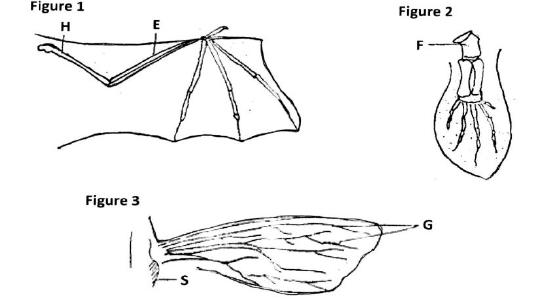 (i) In figure 1, identify bones: H and E
(ii) Name the type of joint formed by bones H and E.
(iii) Identify the type of structures shown above and the type of evolution.
Structures:
Type of evolution:
(i) In figure 1, identify bones: H and E
(ii) Name the type of joint formed by bones H and E.
(iii) Identify the type of structures shown above and the type of evolution.
Structures:
Type of evolution:
Date posted: September 16, 2019.
- The figure below shows feet of various birds. Study the diagram and answer the questions that follow.(Solved)
The figure below shows feet of various birds. Study the diagram and answer the questions that follow.
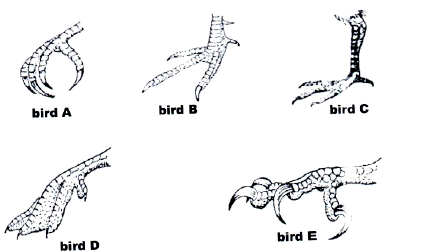 (a) Giving a reason, state the type of food eaten by Bird E.
Food eaten:
Reason:
(b) Name the habitat of bird D and give a reason for your answer.
Habitat:
Reason:
(c) Identify the type of structures shown by the feet above and give a reason for your answer.
Type of structure:
Reason:
(d) State the type of evolution shown by the structures.
(a) Giving a reason, state the type of food eaten by Bird E.
Food eaten:
Reason:
(b) Name the habitat of bird D and give a reason for your answer.
Habitat:
Reason:
(c) Identify the type of structures shown by the feet above and give a reason for your answer.
Type of structure:
Reason:
(d) State the type of evolution shown by the structures.
Date posted: September 16, 2019.
- You are provided with plant specimens below.(Solved)
You are provided with plant specimens below.
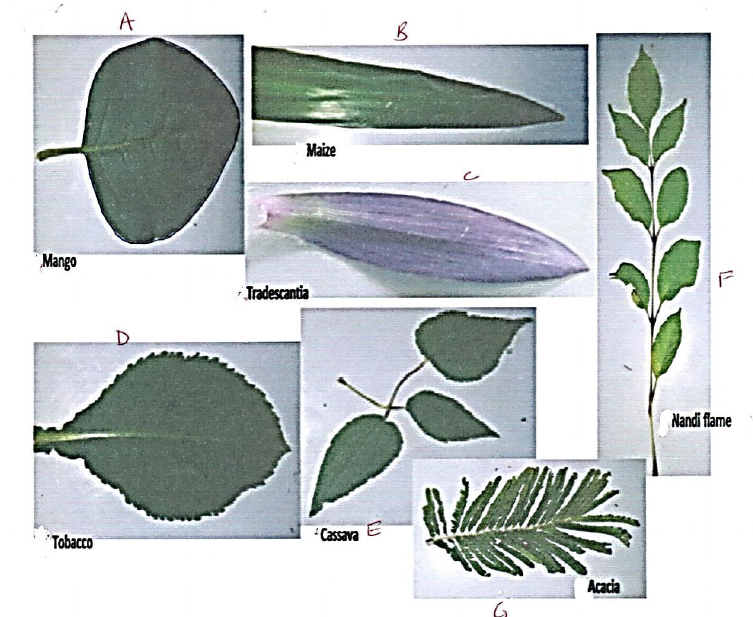 A) Construct a dichotomous key using the features given below in order.
(i) Leaf type
(ii) Leaf venation
(iii) Leaf colour
(iv) Leaf margin
(v) Number of leaflets
(vi) Attachment of leaflets
1) (a) Leaf simple ……………………………………………. go to 2
(b) …………………………………………………………………………….
2) (a) ……………………………………………………………………………
(b) Leaf with network venation …………………………… go to 4
3) (a) ……………………………………………………………………………
(b)…………………………………………………………………………….
4) (a) ……………………………………………………………………………
(b)…………………………………………………………………………….
5) (a) ……………………………………………………………………………
(b)…………………………………………………………………………….
6) (a) ……………………………………………………………………………
(b)…………………………………………………………………………….
B) Using the steps followed, identify the plant specimens provided.
A) Construct a dichotomous key using the features given below in order.
(i) Leaf type
(ii) Leaf venation
(iii) Leaf colour
(iv) Leaf margin
(v) Number of leaflets
(vi) Attachment of leaflets
1) (a) Leaf simple ……………………………………………. go to 2
(b) …………………………………………………………………………….
2) (a) ……………………………………………………………………………
(b) Leaf with network venation …………………………… go to 4
3) (a) ……………………………………………………………………………
(b)…………………………………………………………………………….
4) (a) ……………………………………………………………………………
(b)…………………………………………………………………………….
5) (a) ……………………………………………………………………………
(b)…………………………………………………………………………….
6) (a) ……………………………………………………………………………
(b)…………………………………………………………………………….
B) Using the steps followed, identify the plant specimens provided.

Date posted: September 16, 2019.
- An experiment was carried out to determine the growth rates of bamboo and a variety of maize plants in two adjacent plots.The average height and...(Solved)
An experiment was carried out to determine the growth rates of bamboo and a variety of maize plants in two adjacent plots.The average height and average dry weight of plants from the two populations were determined over a period of twenty weeks. The data is as shown in the table below.
 (a) Between which two weeks did the greatest increase in weight occur in:
(i) Bamboo plants:
(ii) Maize plants:
(b) (i) Which of the two types of plants had a higher productivity by the end of the experiment?
(ii) Give a reason for your answer in (b) (i) above.
(c) Between weeks 14 and 18, the average height of the maize plants remained constant while average dry weight increased.Explain this observation.
(d) Suggest how the change in the average dry weight bamboo and maize plants would have been at week 22 if the experiment was continued.
(e) Why was it appropriate for this experiment to use:
(i) Dry weight instead of fresh weight.
(ii) Weight and height.
(f) Describe how the average height and weight of the plants were determined in this experiment.
(i) Average height.
(ii) Average dry weight.
(g) Give a reason why secondary thickening does not occur in bamboo and maize plants.
(a) Between which two weeks did the greatest increase in weight occur in:
(i) Bamboo plants:
(ii) Maize plants:
(b) (i) Which of the two types of plants had a higher productivity by the end of the experiment?
(ii) Give a reason for your answer in (b) (i) above.
(c) Between weeks 14 and 18, the average height of the maize plants remained constant while average dry weight increased.Explain this observation.
(d) Suggest how the change in the average dry weight bamboo and maize plants would have been at week 22 if the experiment was continued.
(e) Why was it appropriate for this experiment to use:
(i) Dry weight instead of fresh weight.
(ii) Weight and height.
(f) Describe how the average height and weight of the plants were determined in this experiment.
(i) Average height.
(ii) Average dry weight.
(g) Give a reason why secondary thickening does not occur in bamboo and maize plants.
Date posted: September 16, 2019.
- During an ecology, students collected and marked 40 ants and then released them. After 2 days, the students captured another 100 ants, 40 of which...(Solved)
During an ecology, students collected and marked 40 ants and then released them. After 2 days, the students captured another 100 ants, 40 of which had been marked previously.
(i) How many ants were there in the compound? Show your working.
(ii) Give two assumptions of this method in sampling animal population.
Date posted: September 16, 2019.
- Study the food web below representing a certain ecosystem and use it to answer the questions that follow.(Solved)
Study the food web below representing a certain ecosystem and use it to answer the questions that follow.
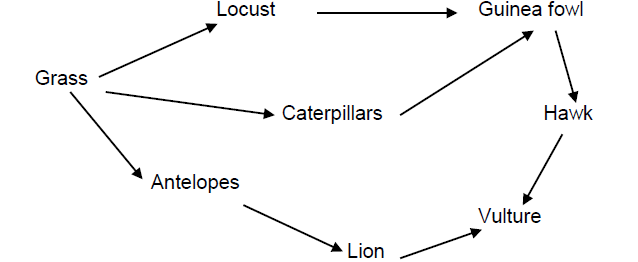 (i) Write down a food chain in which the vulture is a tertiary consumer.
(ii) What would be the effect of introducing gazelles and termites into the ecosystem?
(i) Write down a food chain in which the vulture is a tertiary consumer.
(ii) What would be the effect of introducing gazelles and termites into the ecosystem?
Date posted: September 16, 2019.
- The equation below represents a certain physiological process. Study it and answer the questions below.(Solved)
The equation below represents a certain physiological process. Study it and answer the questions below.
 (i) Name the above process.
(ii) Give two reasons for question (i) above.
(iii) Calculate the respiratory quotient of the compound that was as the substrate.
(iv) Identify the substrate being respired in the above equation.
(v) State one importance of this process to living organisms.
(vi) Name the organelle where the above process takes place in animal cells.
(i) Name the above process.
(ii) Give two reasons for question (i) above.
(iii) Calculate the respiratory quotient of the compound that was as the substrate.
(iv) Identify the substrate being respired in the above equation.
(v) State one importance of this process to living organisms.
(vi) Name the organelle where the above process takes place in animal cells.
Date posted: September 16, 2019.
- A man with normal skin colour got married to a woman with normal skin colour. They gave birth to three children; one of them an...(Solved)
A man with normal skin colour got married to a woman with normal skin colour. They gave birth to three children; one of them an albino.
(a) Identify the probable genotype of the parents using letter (A) for normal gene and (a) for defective gene.
Man:
Woman:
(b) Using a genetic cross; show the genotypes of the offspring.
(c) Give the phenotypic ratio of the offsprings.
Date posted: September 16, 2019.
- Use the graph below to answer the questions that follow.(Solved)
Use the graph below to answer the questions that follow.
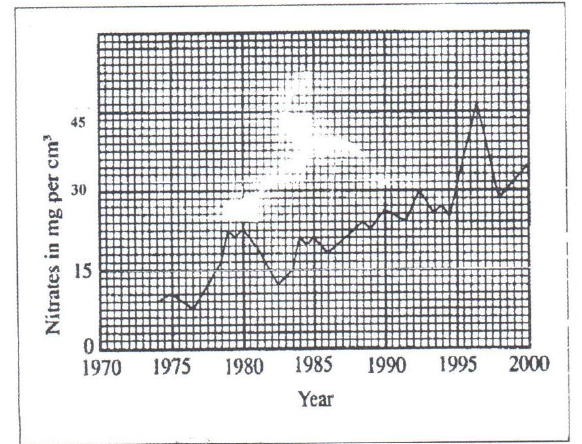 (a) Calculate the difference in nitrate concentration between the highest and lowest.
(b) How can increase in nitrate concentration in the river lead to death of fish?
(c) Suggest one possible sources of nitrate that lead to the pollution in a river.
(a) Calculate the difference in nitrate concentration between the highest and lowest.
(b) How can increase in nitrate concentration in the river lead to death of fish?
(c) Suggest one possible sources of nitrate that lead to the pollution in a river.
Date posted: September 16, 2019.
- The diagram below shows a seed of a certain plant.(Solved)
The diagram below shows a seed of a certain plant.
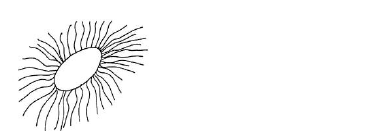 (a) Name the likely agent of dispersal.
(b) Give a reason for your answer.
(a) Name the likely agent of dispersal.
(b) Give a reason for your answer.
Date posted: September 16, 2019.
- Name the source of hydrochloric acid in the mammalian heart.(Solved)
Name the source of hydrochloric acid in the mammalian heart.
Date posted: September 16, 2019.
- Study the diagram and answer the questions that follow.(Solved)
Study the diagram and answer the questions that follow.
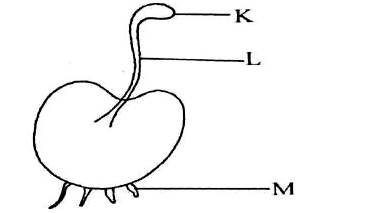 (a) State the division the organism belongs.
(b) Name the part labelled K.
(c) What is the function of the part labelled M?
(a) State the division the organism belongs.
(b) Name the part labelled K.
(c) What is the function of the part labelled M?
Date posted: September 16, 2019.
- The chemical equation below represents a physiological process that takes place in living organisms.(Solved)
The chemical equation below represents a physiological process that takes place in living organisms.
 Name:
(i) The process R:
(ii) Substance Q:
Name:
(i) The process R:
(ii) Substance Q:
Date posted: September 16, 2019.
- Explain how the Iris muscle controls the size of pupil when exposed to bright light.(Solved)
Explain how the Iris muscle controls the size of pupil when exposed to bright light.
Date posted: September 16, 2019.
- Explain why tracheids are not efficient in transporting water up the plant.(Solved)
Explain why tracheids are not efficient in transporting water up the plant.
Date posted: September 16, 2019.
- The diagram below illustrates photographs of plants undergoing a certain process. Study them carefully and answer the questions that follow.(Solved)
The diagram below illustrates photographs of plants undergoing a certain process. Study them carefully and answer the questions that follow.
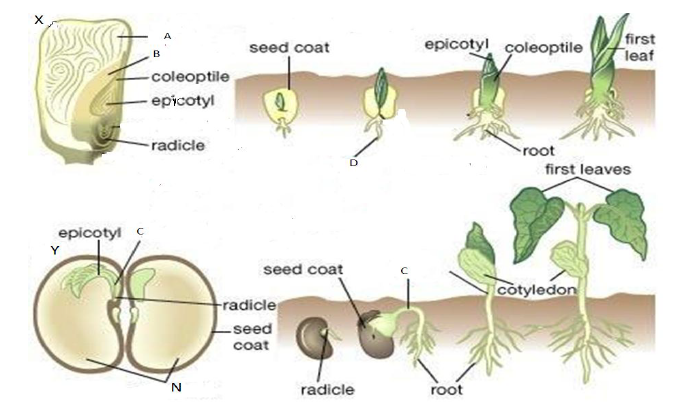 a) i) Name the process illustrated on the photograph.
ii) State two differences in the way the process occurs as illustrated in X and in Y.
b) i) State two roles of part C in the process illustrated above.
ii) State two external factors that are necessary for the process above to take place.
c) Name the parts labelled B and give its function
Name:
Function
d) Using observable features only, name the classes to which the specimen X and Y belong, giving one reason in each case.
a) i) Name the process illustrated on the photograph.
ii) State two differences in the way the process occurs as illustrated in X and in Y.
b) i) State two roles of part C in the process illustrated above.
ii) State two external factors that are necessary for the process above to take place.
c) Name the parts labelled B and give its function
Name:
Function
d) Using observable features only, name the classes to which the specimen X and Y belong, giving one reason in each case.

Date posted: September 16, 2019.
- The diagram below shows a mammalian eye.(Solved)
The diagram below shows a mammalian eye.
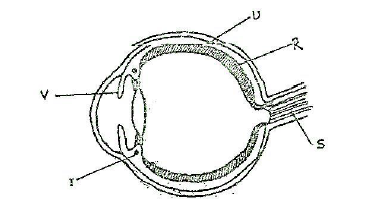 a) Name the parts labeled R, S and T.
b) Give two adaptations of part labeled U.
c) Describe the changes that occur to part V when one moves from a bright room to a dark room.
a) Name the parts labeled R, S and T.
b) Give two adaptations of part labeled U.
c) Describe the changes that occur to part V when one moves from a bright room to a dark room.
Date posted: September 16, 2019.
- The figures below represent mammalian tissue as seen under a light microscope.(Solved)
The figures below represent mammalian tissue as seen under a light microscope.
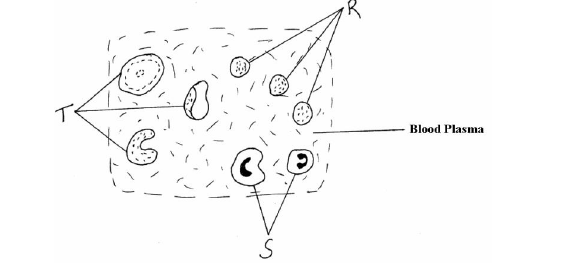 (a) Identify the tissue
(b) Name the cells represented by R,S and T
(c) State the function of structure S and R.
(d) Explain two adaptations of structure T to its function.
(e) Name the hereditary condition a person with structure T is suffering from.
(a) Identify the tissue
(b) Name the cells represented by R,S and T
(c) State the function of structure S and R.
(d) Explain two adaptations of structure T to its function.
(e) Name the hereditary condition a person with structure T is suffering from.
Date posted: September 16, 2019.
- Study the diagrams below and answer the questions that follow.(Solved)
Study the diagrams below and answer the questions that follow.
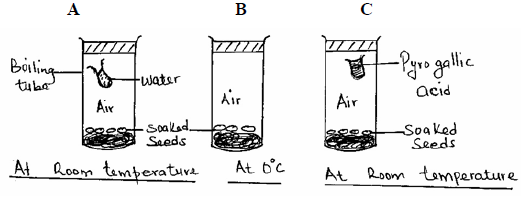 (a) Identify the process being investigated.
(b) With a reason identify the set-up in which germination will occur.
(c) State two roles played by water during germination.
(d) Name three factors inside the seed that causes seed dormancy.
(a) Identify the process being investigated.
(b) With a reason identify the set-up in which germination will occur.
(c) State two roles played by water during germination.
(d) Name three factors inside the seed that causes seed dormancy.
Date posted: September 16, 2019.
- State the role of carnassial teeth in a lion..(Solved)
State the role of carnassial teeth in a lion..
Date posted: September 16, 2019.
- The diagram below shows two potted plants on a laboratory bench near a window.(Solved)
The diagram below shows two potted plants on a laboratory bench near a window.
 a) State one observable difference between the plants I and II.
b) State the importance of the process that is seen in plant I.
c) Explain the process that resulted to appearance of the leaves as in plant I above.
d) Suppose a cell from a leaf of each of the plants I and II is mounted and observed under a microscope. Draw a diagram of a cell from each of the plants leaves.
a) State one observable difference between the plants I and II.
b) State the importance of the process that is seen in plant I.
c) Explain the process that resulted to appearance of the leaves as in plant I above.
d) Suppose a cell from a leaf of each of the plants I and II is mounted and observed under a microscope. Draw a diagram of a cell from each of the plants leaves.
Date posted: September 16, 2019.
- After a colony of penicillin-sensitive bacteria was exposed to antibiotic pencillin, a penicillin resistant emerged. Explain this observation(Solved)
After a colony of penicillin-sensitive bacteria was exposed to antibiotic pencillin, a penicillin resistant emerged. Explain this observation
Date posted: September 16, 2019.
- State the importance of companion cell in phloem tissue.(Solved)
State the importance of companion cell in phloem tissue.
Date posted: September 16, 2019.
- The diagram below represents microvilli on epithelial cells(Solved)
The diagram below represents microvilli on epithelial cells
 (a) Name the parts A and C
(b) Name two parts in the human body where the above epithelial cells are found.
(a) Name the parts A and C
(b) Name two parts in the human body where the above epithelial cells are found.
Date posted: September 16, 2019.
- During an ecological study of a lake, a group of students recorded the following observations.(Solved)
During an ecological study of a lake, a group of students recorded the following observations.
(i) Planktonic crustaceans feed on planktonic algae;
(ii) Small fish feed on planktonic crustaceans, worms and insect larvae;
(iii) Worms feed on insect larvae;
(iv) A bird species feeds on small fish, planktonic crustaceans, worms and large fish;
(v) Insect larvae feed on planktonic algae;
(vi) Large fish feed on small fish.
(a) From this record of observations, construct a food web.
(b) From the food web, isolate and write down a food chain that ends with:-
(i) Bird species as a secondary consumer.
(ii) Large fish as a tertiary consumer.
(c) The biomass of the producers in the lake was found to be greater than that of primary consumers. Explain this observation.
(d) Using the food web, identify three pairs of organisms that compete for food in the lake and for each case, name the food being competed for.
(e) (i) State three ways by which human beings may interfere with this lake ecosystem.
(i) Explain how each of the ways stated in (e) (i) above may affect life in the lake.
Date posted: September 16, 2019.
- A person walked bare feet in a swampy area. After a few weeks he started experiencing abdominal pains and diarrhoea. His urine and stool contained...(Solved)
A person walked bare feet in a swampy area. After a few weeks he started experiencing abdominal pains and diarrhoea. His urine and stool contained blood.
(a) Name the disease the person was likely to be suffering from and the causative agent of the disease
(i) Disease
(ii) Causative agent
(b.) Apart from avoiding walking bare feet in swampy area. State two other ways of controlling the disease.
Date posted: September 13, 2019.
- Explain the meaning of homoiothermic.(Solved)
Explain the meaning of homoiothermic.
Date posted: September 13, 2019.
- You are provided with photographs of animals. Study the photographs and the dichotomous key below to enable you identify the taxonomic group to which each...(Solved)
You are provided with photographs of animals. Study the photographs and the dichotomous key below to enable you identify the taxonomic group to which each animal belongs.
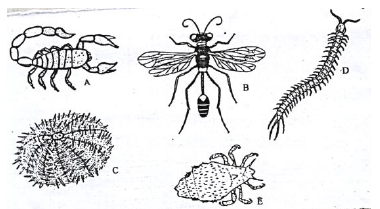 KEY
1. a) Jointed legs present ………………………………………………………………go to 2
b) Jointed legs absent………………………………………………………………..go to 7
2. a) Three pairs of legs ………………………………………………………………..go to 3
b) More than 3 pairs of legs………………………………………………………….go to 5
3. a) Wings present …………………………………………………………………….go to 4
b) Wings absent………………………………………………………………………Anoplura
4. a) One pair of wings…………………………………………………………………Diptera
b) Two pairs of wings……………………………………………………………Hymenoptera
5. a) Four pairs of legs ………………………………………………………………… Arachnida
b) More than ten pairs of legs ………………………………………………………. go to 6
6. a) One pair of legs in each body segment…………………………………………… Chilopoda
b) Two pairs of legs in each body segment ………………………………………… Diplopoda
7. a) Body partially enclosed in a shell………………………………………………… Mollusca
b) Body surface has spiny projection…………………………………………….Echinodermata
a) Using the key, identify the following organisms to their taxonomic groups. In each case, give the sequence of steps which you followed in identifying them.
KEY
1. a) Jointed legs present ………………………………………………………………go to 2
b) Jointed legs absent………………………………………………………………..go to 7
2. a) Three pairs of legs ………………………………………………………………..go to 3
b) More than 3 pairs of legs………………………………………………………….go to 5
3. a) Wings present …………………………………………………………………….go to 4
b) Wings absent………………………………………………………………………Anoplura
4. a) One pair of wings…………………………………………………………………Diptera
b) Two pairs of wings……………………………………………………………Hymenoptera
5. a) Four pairs of legs ………………………………………………………………… Arachnida
b) More than ten pairs of legs ………………………………………………………. go to 6
6. a) One pair of legs in each body segment…………………………………………… Chilopoda
b) Two pairs of legs in each body segment ………………………………………… Diplopoda
7. a) Body partially enclosed in a shell………………………………………………… Mollusca
b) Body surface has spiny projection…………………………………………….Echinodermata
a) Using the key, identify the following organisms to their taxonomic groups. In each case, give the sequence of steps which you followed in identifying them.
 b) i) Using observable features only, state the class to which the animal labeled A and B on the photographs above belong.State two observable features on B, that enabled you to arrive at that answer in (b) (i) above.
b) i) Using observable features only, state the class to which the animal labeled A and B on the photographs above belong.State two observable features on B, that enabled you to arrive at that answer in (b) (i) above.
Date posted: September 13, 2019.
- Study the reaction below and answer the questions that follow.(Solved)
Study the reaction below and answer the questions that follow.
 a) What biological processes are represented by A and B?
b) Identify the product Y.
c) State the bond represented by X.
a) What biological processes are represented by A and B?
b) Identify the product Y.
c) State the bond represented by X.
Date posted: September 13, 2019.